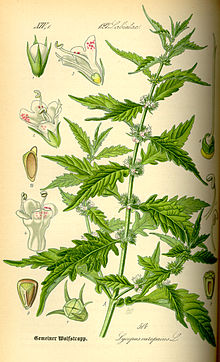|
Lycopus
Lycopus is a genus of herbaceous plants in the family Lamiaceae. The many species are known as water horehound,[3] gypsywort, and bugleweed and are native to Europe, Asia, Australia, and North America.[2] The species are most often found in wetlands, damp meadows, and stream banks. Some of the wetland species have become endangered.[4] DescriptionThe genus includes only perennial species; they spread by both seeds and stems rooting as they grow along the ground. Small white flowers bloom in late summer on leaf axials. Leaves are bright green, pointed, lobed, and like all mints occur in opposite pairs. Some species start with curled purple leaves that unfurl to a bright green coloration. The species in this genus vary in size, but generally grow to about 3–4 ft (91–122 cm).[5] TaxonomyFossil recordFossil seeds of †Lycopus antiquus are known from the Middle Miocene strata of southern Russia, from the Miocene of Lower Lusatia, Germany, and from the Late Miocene strata of western Siberia and Ukraine. Lycopus antiquus has possibly been applied to more than one extinct species which were widely distributed in Europe and Siberia from the Miocene to the Pliocene. Extant Lycopus species whose fruits most resemble L. antiquus, are the East Asian Lycopus lucidus and the Eurasian Lycopus exaltatus.[6] Species
UsesThe plant's juice yields black dye, supposedly used by the Roma in Europe to tan their skin to mimic Egyptians, hence the common name of Gypsywort for Lycopus europaeus. Apothecaries and herbalists used the leaves, stems, and flowers for their astringent and sedative qualities as well as for anxiety, tuberculosis, and palpitations.[5] References
Wikimedia Commons has media related to Lycopus. |
||||||||||||||||||||||||||||||||
